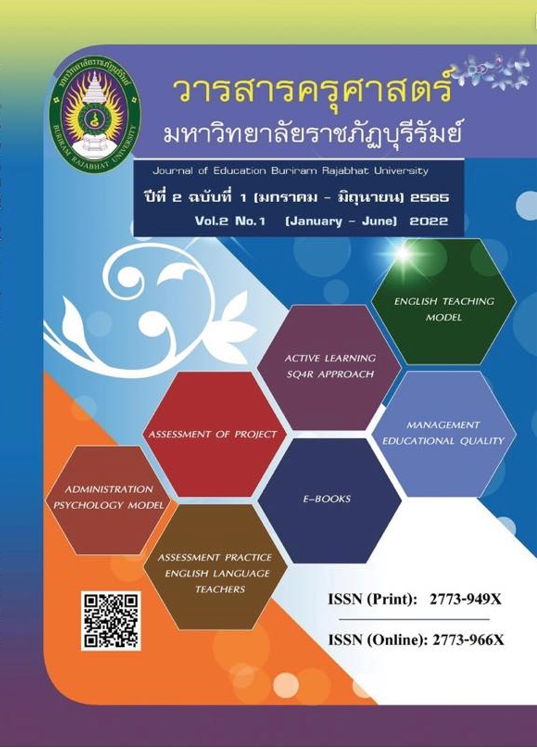Assessment Practice of English Language Teachers in Myanmar
Main Article Content
บทคัดย่อ
Good assessment practices benefit both students and teachers in several ways: They give information to help teachers determine the appropriateness of content and the pace of the lesson. They also help teachers monitor student learning throughout the course. “Assessment” of foreign languages is an important area of examination because it is considered as an essential process influencing both the teaching and the learning practices and beliefs (Cohen, 1994). Moreover, it seems that perceptions that teachers have on assessment are likely to influence their assessment practices. This research is set up to explore teachers’ perceptions of assessment in order to determine their beliefs, attitudes and views that affect their assessment practices. It also seeks to determine whether there are significant differences in teachers’ perceptions of assessment by gender. Data were collected from a questionnaire survey with 130 teachers. Teachers’ perceptions of assessment were measured through a calculation of the percentage, mean and standard deviation. The findings revealed that university teachers who participated in the research reported favorable and positive perceptions of assessment (Average Mean=1.59). Participants considered the ultimate goal of assessment is to evaluate students’ learning progress (Mean=1.79) followed by to make decisions on teaching and learning (Mean=1.76). Most of the teachers also perceived that the basic role of assessment is to raise students’ learning and teaching practices (Mean=1.76). Furthermore, role-play is the most favored type of activities used for conducting assessment by English language teachers (Mean=1.50) and teacher assessment (Mean=1.78) was maintained by a large proportion of the participants.
Downloads
Article Details
บทความที่ได้รับการตีพิมพ์ลิขสิทธิ์เป็นของวารสารครุศาสตร์ มหาวิทยาลัยราชภัฏบุรีรัมย์ อนุญาตให้เผยแพร่เพื่อการศึกษาและวิจัย ในวงการวิชาการ ไม่อนุญาตการใช้ประโยชน์เพื่อการแสวงหากำไร
ข้อความที่ปรากฏในบทความเป็นความคิดเห็นส่วนตัวของผู้แต่ง ซึ่งวารสารครุศาสตร์ มหาวิทยาลัยราชภัฏบุรีรัมย์ ได้ประเมินคุณภาพตามหลักวิชาการ ผลกระทบอันเกิดจากความคิดเห็นของผู้แต่งเป็นความรับผิดชอบของผู้แต่งเอง
เอกสารอ้างอิง
Airasian, P. W. 1994. Classroom assessment, New York: McGraw-Hill. Anderson, R. S. (1998). Why talk about different ways to grade? The shift from traditional assessment to alternative assessment. New directions for Teaching and Learning, 1998(74).
Bayyurt, Y. & Altinmakas, D. (2012). A WE based English Communication Skills Course at a Turkish University. In A. Matsuda (Ed.), Principles and Practices of Teaching English as an International Language. Bristol: Multilingual Matters.
(1) (PDF) Assessment Practices in Teaching English as an International Language. Available from: https://www.researchgate.net/publication/ 328643382_Assessment_Practices_in_Teaching_English_as_an_International_Language [accessed Jan 26 2022].
Black, P. J., & Wiliam, D. (1998b). Inside the black box: Raising standards through classroom assessment. London: King’s college London School of Education.
Brown, G. T. 2006. “Teachers’ conception of assessment: validation of an abridged instrument,” Psychological Reports, 99(1), August 2006.
Chamot, A., & O'Malley, M. (1994). The CALLA Handbook: Implementing the Cognitive Academic Language Learning Approach. Reading, MA: Addison Wesley.
Davies, A, Brown, A, Elder, C, Hill, K, Lumley, T and McNamara, T (1999) Dictionary of language testing, Cambridge: Cambridge University Press / UCLES.
Dhindsa, H., Omar, K., & Waldrip, B. (2007, August 1). Upper Secondary Bruneian Science Students' Perceptions of Assessment. International Journal of Science Education, 29(10)
Dweck, C. S. (2006). Mindset. New York, NY: Random House Elliot.
Hamp-Lyons, L., & Davies, A. (2008). The English of English tests: Bias revisited. World Englishes, 27(1), 26–39 Linn, R. and Gronlund, N. 2000. Measurement and Assessment in Teaching, 8th ed., Upper Saddle River, NJ: Merrill, 2000.
Goodrum, D., Hackling, M., & Rennie, L. (2001). The status and quality of teaching and learning of science in Australian schools. Canberra: Department of Education, Training and Youth Affairs.
McMillan, J.H., Myran, S., & Workman, D. (2002). Elementary teachers’ classroom assessment and grading practice. The Journal of Educational Research, 95(4).
Nunan, D. 1988. The learner centred curriculum. A research in second language teaching. Cambridge: Cambridge University Press.
Prosser, M. & Trigwell, K. (1999). Understanding learning and teaching: The experience in higher education. Buckingham: SRHE & Open University Press
Reynolds, C. R., Livingston, R. B., & Willson, V. (2006). Measurement and Assessment in Education. Boston: Al-lyn and Bacon Shohamy, 2001 Shohamy, E. 1993: The power of tests: the impact of language tests on teaching and learning. Washington, DC: The National Foreign Language Center at Johns Hopkins University
Shohamy, E. (2001). The power of tests: A critical perspective on the uses of language tests. Harlow, England: Longman
Short, D. 1993. Assessing integrated language and content instruction. TESOL Quarterly. 27.CrossRef | Google Scholar


